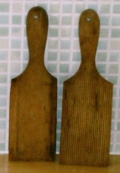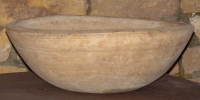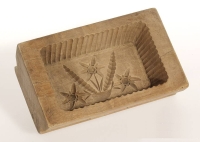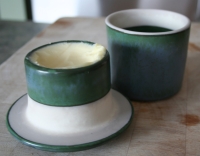-
History of:
- Resources about:
- More:
- Baby walkers
- Bakehouses
- Bed warmers
- Beer, ale mullers
- Besoms, broom-making
- Box, cabinet, and press beds
- Butter crocks, coolers
- Candle snuffers, tallow
- Clothes horses, airers
- Cooking on a peat fire
- Drying grounds
- Enamel cookware
- Fireplaces
- Irons for frills & ruffles
- Knitting sheaths, belts
- Laundry starch
- Log cabin beds
- Lye and chamber-lye
- Mangles
- Marseilles quilts
- Medieval beds
- Rag rugs
- Rushlights, dips & nips
- Straw mattresses
- Sugar cutters - nips & tongs
- Tablecloths
- Tinderboxes
- Washing bats and beetles
- Washing dollies
- List of all articles
Subscribe to RSS feed or get email updates.
Where a gentle way is used in making Butter, it will cut like Wax, and it should especially be well wrought with the Hands, when it is fresh taken from the Churn and salted for common use; for if the Milk be not well work'd out of it, the Butter will not keep.
Richard Bradley, The Country Housewife, 1728
Pack your butter in a clean, scalded firkin [small barrel], cover it with strong brine, and spread a cloth all over the top, and it will keep good ...
Lydia Child, The American Frugal Housewife, 1835
With respect to the prices of butter, it appears by the household-book of Lord North that a pound of butter in the reign of Queen Elizabeth cost fourpence: at the present time [the summer of 1835], a pound of the best butter in the west of England costs from sevenpence to eightpence, while in the metropolis the price is fourteenpence.
(The Penny Magazine, 1835)
After churning - butter-working, storage, crocks, coolers
<<<< Butter-making - churns >> Storage, serving, crocks >> songs
Shaping & Keeping
 After the cream had formed
lumps of butter, it still wasn't ready for serving or preserving. It was taken out
of the churn, probably with wooden scoops,
ready to be refined, salted and shaped.
After the cream had formed
lumps of butter, it still wasn't ready for serving or preserving. It was taken out
of the churn, probably with wooden scoops,
ready to be refined, salted and shaped.
Removing buttermilk, adding salt
All the buttermilk separated from the butterfat had to be rinsed out. This would improve texture and flavour, and also help the butter keep well, since milk turns rancid more quickly than fat alone. Salt was usually mixed in at this stage - for flavour and preservation. The rinsing could be done simply by washing in water, followed by draining, salting and working or "kneading" the butter with a pair of wooden butter hands, (see right), or with bare hands.
 Until the 19th century
working the butter with your hands was the norm. The wooden bowl (left) was used
by Yorkshire butter-makers to hold the butter while they "clashed" it - prepared
it by hand. In the 19th century the
butter worker - a wooden tray with roller - was invented to help with these
processes. In Wales
butter working was done with a
circular wooden tool in a round bowl like an open shallow barrel.
Until the 19th century
working the butter with your hands was the norm. The wooden bowl (left) was used
by Yorkshire butter-makers to hold the butter while they "clashed" it - prepared
it by hand. In the 19th century the
butter worker - a wooden tray with roller - was invented to help with these
processes. In Wales
butter working was done with a
circular wooden tool in a round bowl like an open shallow barrel.
Butter hands, butter moulds
 The
wooden spatulas/paddles (above) used for manipulating the butter have several different
names - Scotch hands, butter pats, butter paddles, beaters, clappers, spades among
others. They can be put to use in various ways. As well as doubling up as scoops
for taking butter from the churn, they can stir, cut, slap, lift. They can cut and
shape the butter into a block, and then mark its top with a local design of crosses
or grooves. Or they may be used to press butter into a mould. (See right)
The
wooden spatulas/paddles (above) used for manipulating the butter have several different
names - Scotch hands, butter pats, butter paddles, beaters, clappers, spades among
others. They can be put to use in various ways. As well as doubling up as scoops
for taking butter from the churn, they can stir, cut, slap, lift. They can cut and
shape the butter into a block, and then mark its top with a local design of crosses
or grooves. Or they may be used to press butter into a mould. (See right)
 In grocers' shops in Britain
the "hands" were used well into the 20th century to cut a piece of butter from a
large block, on request from a customer. In the kitchen they were used to make
individual butter balls for serving at table - just roll a small lump around
between the two wooden pats.
In grocers' shops in Britain
the "hands" were used well into the 20th century to cut a piece of butter from a
large block, on request from a customer. In the kitchen they were used to make
individual butter balls for serving at table - just roll a small lump around
between the two wooden pats.
In England butter might be formed into various shapes. This 18th century stamp was designed to keep a rounded top on a lump of butter. During the 19th century half-pound bricks became a standard shape, even though bulk buyers bought barrels or large blocks. Patterns, stamped or cut, might mark the original source. The patterns varied by region - with cross designs associated with the north-west and thistles with Yorkshire. In the US both pounds and half-pounds of butter were common, sometimes wrapped in good quality dairy cloths, not just in thin butter muslin/cheeseloth.
Butter-moulds, or wooden stamps for moulding fresh butter, are much used, and are made in a variety of forms and shapes. In using them, let them be kept scrupulously clean, and before the butter is pressed in, the interior should be well wetted with cold water; the butter must then be pressed in, the mould opened, and the perfect shape taken out. The butter may be then dished, and garnished with a wreath of parsley, if for a cheese course; if for breakfast, put it into an ornamental butter-dish, with a little water at the bottom, should the weather be very warm.
Isabella Beeton, Book of Household Management, 1861
Crocks, coolers, dishes
 Bog butter is famously ancient butter found buried in centuries-old
layers of Irish peat, in wooden containers. Although archaeologists aren't sure
of the reasons it was buried, it shows that the people who made it knew it must
be packed away from contact with air, and kept cool.
Bog butter is famously ancient butter found buried in centuries-old
layers of Irish peat, in wooden containers. Although archaeologists aren't sure
of the reasons it was buried, it shows that the people who made it knew it must
be packed away from contact with air, and kept cool.
Butter storage presents different problems in different climates, but whatever the temperature, its surface must be covered - packed into barrels or crocks, or wrapped in leaves or paper. Water or brine may be used to form an air-tight seal at the same time as helping to keep it cool. This was sometimes called pickling the butter.
Really hot countries where butter is made in quantity, like India, use clarified butter (ghee), with the last traces of water and milk solids removed to help preservation. When English-speaking migrants (and other northern Europeans) arrived in warmer countries they resorted to keeping butter down a well, or in elaborate coolers with cold water reservoirs and draped cloths. Unglazed earthenware dishes and covers were useful as they would soak up cold water.
Coolers with bell-shaped domed lids were in use long before the recent popularity of "butter bells" in the USA. (Above right) These are often not bell-shaped at all, and are just like the French butter dish or French butter crock - based on a 19th century design from France, but barely known there now. The old priorities have changed in an age of huge refrigerators, and "French" butter crocks are now desirable for keeping butter spreadable, neither too cold nor too warm.
 Back in Britain, cooling was a slight problem in summer, but more urgent if butter
had to sit for hours in a warm dining room. Butter cooler there often meant a handsome
silver dish for the table, resting on a compartment filled with water or possibly
ice. Decorative silver butter coolers were well-known in 19th and early 20th century
North America, where "table
rituals involving the consumption of butter" (pdf) became important. American
coolers held an array of small portions destined for the individual dishes known
as butter pats. These ceramic pats, which are now very popular with collectors in
the US, were not used in the UK, where butter pat always means either a small lump
of butter, or a spatula/paddle used for handling butter.
Back in Britain, cooling was a slight problem in summer, but more urgent if butter
had to sit for hours in a warm dining room. Butter cooler there often meant a handsome
silver dish for the table, resting on a compartment filled with water or possibly
ice. Decorative silver butter coolers were well-known in 19th and early 20th century
North America, where "table
rituals involving the consumption of butter" (pdf) became important. American
coolers held an array of small portions destined for the individual dishes known
as butter pats. These ceramic pats, which are now very popular with collectors in
the US, were not used in the UK, where butter pat always means either a small lump
of butter, or a spatula/paddle used for handling butter.
Pats, curls, rolls, and butter shaped by stamping were served in well-to-do Victorian homes in Britain. The most elaborate butter "models" were created with two-piece wooden moulds.
Churning songs
Tibet had traditional churning songs, and so did most butter-making cultures. Variations of "Come, butter, come" are the best-known in English, by far.
Come, butter, come,
Come, butter, come,
Peter's standing at the gate,
Waiting for a buttered cake,
Come, butter, come.
See also:
- A Gaelic churning song from Scotland with English translation
- Punjabi churning song with English translation
- Churning songs from North Carolina
- Song by Silas Dinsmore (Texas, early 19th C) (p199)
- Southern Appalachian churning songs
You may like our new sister site Home Things Past where you'll find articles about antiques, vintage kitchen stuff, crafts, and other things to do with home life in the past. There's space for comments and discussion too. Please do take a look and add your thoughts. (Comments don't appear instantly.)
For sources please refer to the books page, and/or the excerpts quoted on the pages of this website, and note that many links lead to museum sites. Feel free to ask if you're looking for a specific reference - feedback is always welcome anyway. Unfortunately, it's not possible to help you with queries about prices or valuation.


